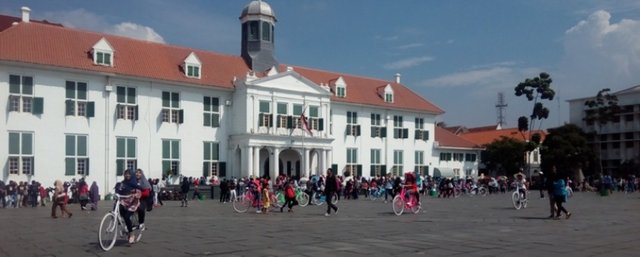A Brief History of Old Buildings, Old Town Jakarta As a Heritage of the Dutch Age
KOTA Tua Jakarta is located in Pinangsia Village, Tamansari District, West Jakarta Municipality. Currently, the Kota Tua area is located in two municipal areas, namely North Jakarta and West Jakarta. Old Town as the forerunner of Jakarta, certainly save a lot of stories behind the magnificent building (old) cultural heritage of the past from the Dutch colonial era.
 image source [1]
image source [1]The Old City of Jakarta, its northern borders with Fish Market, Sunda Kalapa Port and Java Sea, Southern side is bordered by Batu Jembatan and Asemka Road, West bordering with Kali Krukut and East bordering Ciliwung River.
Old Town of Jakarta in the past is a city of seizure that became a symbol of glory for anyone who can master it. Not surprisingly, starting from the Kingdom of Tarumanegara, Sunda Kingdom -Pajajaran, Banten Sultanate -Jayakarta, Verenigde Oost-indische Compagnie (VOC), Government of Japan, until now the Republic of Indonesia through the Government of DKI Jakarta, keep trying to maintain it became the number one city in this country.
In 1526, Fatahillah, sent by the Demak Sultanate, attacked the port of Sunda Kelapa in the Hindu Pajajaran kingdom, later named Jayakarta. The city is only 15 hectares and has a traditional Javanese port town planning. In 1619, the VOC destroyed Jayakarta under the command of Jan Pieterszoon Coen. One year later, the VOC built a new city called Batavia in honor of Batavieren , the ancestor of the Dutch nation. The city is centered around the eastern edge of the Ciliwung River, currently the Fatahillah Square.
The inhabitants of Batavia are called "Batavianen", later known as the Betawi tribe, made up of ethnic creoles who are descendants of various ethnicities who inhabit Batavia. In 1635, the city extends to the western edge of the Ciliwung River, in the former Jayakarta ruins. The city is designed in European Dutch style complete with castle (Kasteel Batavia), city walls, and canals. The city is organized into several blocks separated by channels. The city of Batavia was completed in 1650. Batavia later became the headquarters of the VOC in the East Indies. Canals filled because of the emergence of a tropical epidemic within the city walls due to poor sanitation. The city began to spread south after the epidemic of 1835 and 1870 pushed many people out of the narrow city into the Weltevreden region (now the area around Merdeka Square). Batavia became the administrative center of the Dutch East Indies. In 1942, during the Japanese occupation, Batavia changed its name to Jakarta and still serves as the capital of Indonesia until now.
In 1972, the Governor of Jakarta, Ali Sadikin, issued an official decree making the Old City a heritage site. This governor's decision is aimed at protecting the architectural history of the city or at least the remaining buildings there. [1]
Town of Jakarta in the past is a city of seizure that became a symbol of glory for anyone who can master it. Not surprisingly, starting from the Kingdom of Tarumanegara, Sunda Kingdom -Pajajaran, Banten Sultanate -Jayakarta, Verenigde Oost-indische Compagnie (VOC), Government of Japan, until now the Republic of Indonesia
Thank for visiting my blog @evasantika
Yes your good comment
Hi! I am a robot. I just upvoted you! I found similar content that readers might be interested in:
https://steemit.com/history/@risky-author/jakarta-history-old-town-20171027t165021822z